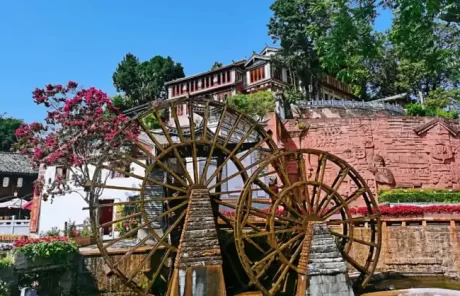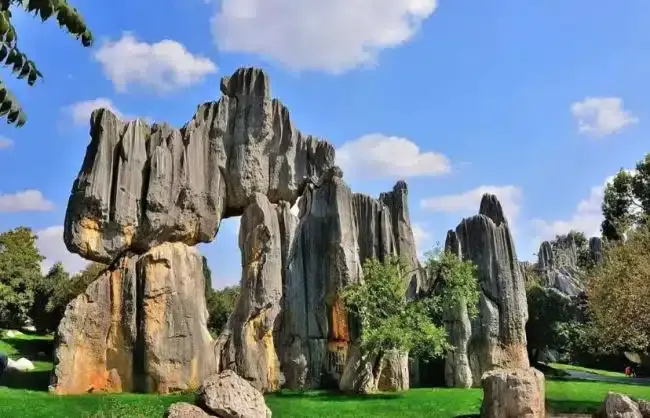Yunnan Travel Guide: Plan Your Ultimate Trip to Yunnan
When you are planning a trip to Yunnan, you can expect adventures and experiences like you have never encountered before. Situated on the southwestern frontier of China, Yunnan is a compelling land of cultural complexities and varied terrain, of staggering natural beauty and thrilling outdoor adventures.
Unsurprisingly, as a place with mountains, plateaus, basins, and gorges distributed throughout, Yunnan has plenty of variety on offer. And this Yunnan Travel Guide is meticulously designed to help you discover its diverse wonders. We show you destinations not to be missed, the best things to do, provide you with weather and climate information, and offer real insider travel tips.
Yunnan is famous for its many time-honored ancient towns, where the authentic cultures and lives of over 25 minority groups are well-preserved. There are so many majestic snow mountains and gorges offering stunning landscapes and exhilarating hiking opportunities. Its northwest is adjacent to Tibet, offering Tibet-style landscape, monastery, and life. While Xishuangbanna in its southmost region is blessed with tropical scenery and a rich Dai ethnic culture and customs.
Read more Top 6 Reasons to Visit Yunnan

Chinese: 云南 yún nán
Location: Southwest China
Population (urban area): 46,930,000
Why Visit Yunnan?
- Cultural Diversity: Yunnan is home to over 25 ethnic minority groups. Its ethnic plurality offers visitors a chance to glimpse into the distinct language, attire, architecture, and traditions of Yi, Bai, Hani, and many other ethnic groups.
- Breathtaking Landscapes: Yunnan boasts unparalleled and diverse natural beauties. Far more than the Jade Dragon Snow Mountain, mystical Shangri-La, picturesque Erhai Lake, and the mesmerizing Stone Forest, it offers more enchanting wonders, from deep gorges, and towering mountains to tropical rainforest and grassland lakes.
- Time-honored Ancient Towns: The many ancient towns are also a highlight of Yunnan, with Dali Ancient Town, Lijiang Ancient Town, and Jianshui Ancient Town being some of the most famous ones. Each of them is historically and culturally rich.
- Outdoor Activities: Yunnan will not disappoint people who love outdoor adventures. Its various snow mountains, gorges, and picturesque landscapes offer visitors abundant chances for hiking, camping, cycling, etc.
- Delicious Yunnan Food: Yunnan is where you can entertain your taste buds with diverse distinctive and enticing food. Combining various ethnic tastes, Yunnan food is renowned for its unique flavors and specialties.
……
Best Places to Travel in Yunnan
Below are some of the popular Yunnan destinations that showcase its essential highlights, rich heritage, and representative attractions.
Top Tourist Attractions in Yunnan
A popular destination in southwestern China, Yunnan is celebrated for its diverse natural landscapes and rich ethnic cultures. It offers a wide range of natural landscapes, from snow-capped mountains and deep gorges to tranquil lakes and dramatic karst formations.
In addition, the province is also home to numerous ancient ethnic towns, villages, and colorful cultural traditions. For generations, the ethnic minority people have created distinctive agricultural landscapes in this “Land of Colorful Clouds,” with Dongchuan Red Land and Yuanyang Rice Terraces some of its best agricultural wonders.
The following top attractions in Yunnan will show you the essence of this diverse land.
Visit the Stone Forest
The Stone Forest is actually a large amount of towering stone pillars which is a unique karst landscape formed by millions of years of erosion and geological movements. There are observation decks available allowing visitors to marvel at the panoramic views of the giant stones in different heights, thicknesses, and shapes.
Scattering the Stone Forest Scenic Area are several ethnic villages, each of which maintained their unique architecture and culture. Visitors can also visit the nearby ethnic villages for immersive cultural experiences.

Cycle around Erhai Lake Scenic Resort
An iconic attraction in Dali and Yunnan, Erhai Lake is surrounded by lush greenery, breathtaking mountains, ancient villages, and numerous historical relics. Besides appreciating its stunning waterscape on a boat, cycling around the lake offers a more flexible way to appreciate its waterfront scenery and cultural heritage.
During the cycling, you can explore all the surrounding sceneries at your own pace and freely stop at any spot for photography or cultural exploration.
Marvel at the Magnificent Yuanyang Rice Terraces
Spanning among the slopes of the Ailao Mountains, Yuanyang Rice Terraces is an artificial marvel crafted by generations of hard work of local Hani ethnic people. These terraces show different sizes and shapes, extending from river valleys up to mountains over 2,000 meters high, with a single slope containing as many as 3,000 steps.
Every year, from mid-November to March, the terraces will be filled with water after the harvest. This is a great time for sightseeing and photography in this area when the water perfectly mirrors the sunlight and creates stunning shadow effects.
The Hani people have lived and toiled on the terraces for generations. Visitors can also make a visit to a local Hani village to look into their life, culture, and symbiotic relationship with nature.
Explore Jade Dragon Snow Mountain
Located within Lijiang, Jade Dragon Snow Mountain boasts the closest snow-capped mountain to the equator in the Northern Hemisphere, which is composed of 13 peaks and stretches a length of about 75 kilometers.
Some of the top attractions here include:
- Glacier Park: Oceanic glaciers that are the nearest to the equator in Eurasia.
- Blue Moon Valley: Where crystal-clear waters are surrounded by lush vegetation and snow-capped mountains.
- Spruce Meadow & Yak Meadow: Offer great panoramic views of the surrounding snow-capped peaks, pristine forests, alpine meadows, and stunning sunrise.
- Ganhaizi: Located at the foot of the Jade Dragon Snow Mountain. The gentle undulating terrain, expansive grassland spotted by pine trees offers a typical highland pasture scenery.
Enjoy Hiking at the Tiger Leaping Gorge
Being claimed as one of the “World’s Top Ten Classic Hiking Trails”, the Tiger Leaping Gorge ranks as the fourth-largest canyon in the world, and the second-largest one in China. It has the Jade Dragon Snow Mountain and Haba Snow Mountain as its backdrops, and with the Jinsha River coursing through it, offering exceptional canyon and mountain scenery.
The entire gorge can be divided into three sections: Upper, Middle, and Lower, with a total length of about 20 kilometers. Each section offers distinct but equally spectacular landscapes. Visitors can hike either part or the whole gorge depending on their time and energy.

Visit the Old Town of Lijiang
Also called Dayan Ancient Town, the UNESCO-listed Lijiang Ancient Town boasts a history of over 800 years, once serving as an important hub on the Ancient Tea Horse Road. With the Jade Dragon Snow Mountain as a backdrop, and crisscrossed by an intricate network of waterways, Lijiang Ancient Town seamlessly blends the atmosphere and charm of a water town and mountain town.
The waterways lace the town with dense bridges, forming a distinctive feature of this town. The rich history and ethnic groups endowed the town with numerous traditional ancient dwellings combining features of Han Chinese, Tibetan, and Bai architecture.
Related reading: Top Things to Do in Kunming, How to Plan a Yunnan Tour
Yunnan Weather and Best Places to Go in Each Season
Yunnan enjoys a subtropical plateau monsoon climate, being characterized by diverse climate types, distinct dry and wet seasons, relatively small annual temperature variation, but a large diurnal temperature range.
July is the hottest month in Yunnan with the average temperatures hovering around 20°C to 23°C, while the coldest month is January, with an average temperature of about 7°C to 11°C.
In the same region, temperatures can vary significantly with altitude, locals describe this phenomenon with the saying “four seasons within a single mountain and different climates within a ten-mile radius”.
Thanks to the diverse terrain, each part of Yunnan features different climate types, making it suitable to visit all year round. The northwest Yunnan sees long winters, short springs and autumns. The eastern and central parts enjoy a more temperate climate, featuring spring-like weather all year round. The southern and southwestern parts of Yunnan are south of the Tropic of Cancer, featuring a tropical climate with long summers.
May to October is the rainy season in Yunnan, with approximately 85% of the annual rainfall occurring in this period. Thus, our recommended best time to visit Yunnan is from October to April, considering the more sunny days and clearer sky.
Recommended Places to Go in Yunnan in Different Seasons
- Visit Yunnan in Spring: Luoping, Dali, Kunming
- Summer: Puzhehei, Lijiang Ancient Town, Luguhu Lake, Shangri-La, Dali, Kunming
- Autumn: Tengchong, Pudacuo National Park in Shangri-La, Dongchuan Red Land, Meili Snow Mountain, Dali, Lijiang, Kunming
- Winter: Yuanyang Rice Terraces, Xishuangbanna, Lijiang, Dali, Kunming
Related reading: Kunming Weather and Best Time to Visit
Main Ethnic Groups in Yunnan & Colorful Cultures
Yunnan is home to 25 minority ethnic groups, each of which maintains a unique culture and way of life. Some of the main ethnic groups include Yi, Bai, Hani, Dai, Zhuang, Miao, Naxi, Yao, Tibetan, Jingpo, Buyi, etc.
- Yi Ethnic Group: The largest minority in Yunnan; mainly resides in Honghe Prefecture, Dali Bai Autonomous Prefecture, Pu’er City, Yuxi City, etc.; celebrate traditional Torch Festival, and known for their unique singing and dancing forms.
- Bai Ethnic Group: The second largest minority in Yunnan; mainly resides in Dali Bai Autonomous Prefecture; revere the white color; their tea culture known as “Three-Course Tea” is very popular; their important traditional festivals include “Third Month Street” and “Circumambulation of the Three Temples”.
- Hani Ethnic Group: Mainly resides in the Ailao Mountains in the Honghe region; known for their terrace culture as they reclaimed mountain slopes into breathtaking terraced paddies; their important festivals include Gatangpa Festival (the Hani New Year) and October New Year Festival (commemorates the ancestors).
- Dai Ethnic Group: Mainly resides in Xishuangbanna Dai Autonomous Prefecture, and Dehong Dai and Jingpo Autonomous Prefecture; Water-splashing Festival is their most known festival; also known for their distinctive dances and music.
- Naxi Ethnic Group: Mainly resides in Lijiang Naxi Autonomous County; boasts a long history and unique culture; have their own language and script, the Naxi script is the oldest minority pictographic script in Yunnan.
Recommended Yunnan Tours with Minority Culture Experiences:

Yunnan Transportation
How to Get to Yunnan
By flight
Flying is the most popular way to reach Yunnan quickly and easily, given the presence of several civil airports in the province.
Some of the major airports in Yunnan include Kunming Changshui International Airport, Lijiang Sanyi Airport, Xishuangbanna Gasa International Airport, Dali Airport, Tengchong Tuofeng Airport, etc.
Kunming Changshui International Airport is the largest as well as the busiest airport in Yunnan, offering most international flights to South Asia and Southeast Asia in China. As an important aviation hub in the country, it offers frequent direct flights connecting most domestic cities, like Beijing, Shanghai, Guangzhou, Shenzhen, Xian, etc. Moreover, there are also direct international flights to and from cities in Southeast Asia, South Asia, Europe, and North America.
Lijiang Sanyi Airport, Xishuangbanna Gasa Airport, and Dali Fengyi Airport serve as gateways in their regions relatively. They all operate direct flights to and from major domestic cities like Beijing, Shanghai, Guangzhou, Chengdu, Xian, etc.
By train
Kunming South Railway Station is the No. 1 high-speed railway station in Yunnan, offering direct high-speed trains to/from major domestic cities like Beijing, Shanghai, Guangzhou, Chengdu, Xian, Guilin, Hangzhou, etc.
Additionally, there are more high-speed railway stations connecting popular tourist routes in Yunnan, including Dali Station, Lijiang Station, Puzhehei Station, Guangnan Station, and Mile Station. These stations allow tourists to travel to/from Kunming and surrounding regions conveniently.
How to Travel around Yunnan
To travel between major cities in Yunnan, high-speed trains and planes are the top-recommended options.
Long-distance bus is the major transportation mode to reach some remote areas and towns, such as Shangri-La, Lugu Lake, or Puzhehei. You will drive through mountainous roads with beautiful scenery along the way.
When traveling around major cities like Kunming, Dali, and Lijiang, local buses and taxis are both convenient and cheap. And within places like Dali Ancient Town, Lijiang Ancient Town, and Jianshui Ancient Town, most attractions can be accessed on foot.

How to Plan a Yunnan Tour
Yunnan is diverse and large. Typically, we recommend to plan for around 6-10 days for a classic Yunnan trip to Kunming, Dali, Lijiang, and Shangri-La. Arrange the sights and destination based on your preferences and time schedule.
If with limited time, 4 or 5 days will also be enough for you to explore two of its popular destinations, like Kunming and Dali, Dali and Lijiang, etc.
With more days available, that means you can enjoy an in-depth Yunnan tour including ethnic family visits, Tiger Leaping Gorge hiking, Yuanyang Rice Terraces photography, or Jianshui exploration. Please feel free to contact us to customize your Yunnan tour with these unique experiences.
Related Reading:









